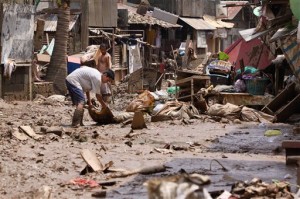PH is 3rd most disaster-prone country in the world–report
MANILA, Philippines–The Philippines is the third most disaster-prone country in the world mainly due to high exposure to natural calamities, a new international report showed.
The World Disaster Report 2012, released in Brussels on Oct. 11, also said the Philippines could spare up to 20 million of its people- roughly a fifth of the total population- from natural disasters through improving the protection of coral reefs, a primary line of defense against coastal hazards, particularly tsunamis.
Tropical and coastal nations led the list of countries at high risk for disasters, with Pacific countries Tonga and Vanuatu rated first and second, respectively.
Of the top three at risk, however, the Philippines had the best rating on adaptation measures, with scores similar to that of Malaysia and Thailand, countries farther down the overall risk rankings at 91st and 92nd place, respectively.
The Mediterranean archipelago of Malta and Middle Eastern country Qatar, meanwhile, are the two lowest-risk countries, according to the report.
Article continues after this advertisement“The top fifteen most at-risk nations are all tropical and coastal where coastal habitats like reefs and mangroves are incredibly important for people’s lives and livelihoods. Reefs, for example, can reduce wave energy approaching coasts by more than 85 percent,” The Conservancy said in a statement posted on its website.
Article continues after this advertisement“What is conspicuous is that among the 15 countries with the highest risk worldwide happen to be island states–including Vanuatu, Tonga and the Philippines at positions one to three. Owing to their proximity to the sea, island states are particularly exposed to the natural hazards of cyclones, flooding and sea level rise,” read the report.
African and Latin American countries also made up much of the top half of the list while Middle Eastern, European and North American countries were rated among the low-risk nations.
The report, a collaboration among the United Nations University’s Institute for Environment and Human Security (UNU-EHS), the German Alliance for Development Works (Alliance), and US-based environment group The Nature Conservancy, rated the disaster risk of some 173 countries around the world using “globally available data” on their individual exposure and susceptibility to disasters and coping and adaptive capacities in the event of natural calamities.
Apart from an overall rating, the report also released country scores on five indicators: disaster exposure, vulnerability, susceptibility, lack of coping capacities and lack of adaptive capacities.
“The index reveals global hotspots for disaster risk in Oceania, Southeast Asia, the southern Sahel and especially in Central America and the Caribbean. In these places, a very high threat of natural disasters and climate change meets very vulnerable communities,” Joern Birkmann, vulnerability researcher at the UNU-EHS, said in a statement.
The report also noted how disaster preparedness, mitigation and adaptation measures implemented by governments could reduce risk. The Netherlands, for instance, is among nations with high exposure to disasters but is able to cut the risk through highly developed coping and adaptation measures.
“Very high exposure is a significant risk driver, although a high development level of society can counteract this substantially, as the example of the Netherlands shows… thanks to social, economic, ecological and institutional factors, the Netherlands has reduced its disaster risk enormously,” said the report.
The study further noted the increasing incidence of natural disasters through man-made environmental degradation and climate change.
The report said some 4,130 natural disasters were recorded nationwide from 2002 to 2011, leaving more than a million victims and an economic loss of roughly $1.195 trillion.
“So far, people have rarely been the direct trigger of such disasters. But with their devastating interventions in nature, they have massively raised the hazard potential. The destruction of mangrove forests and coral reefs, for example off the coasts of Southeast Asia, has reduced protection against tidal waves and flooding,” said the report.
“The clearcutting of mountain forests exacerbates soil erosion and thus, as in Pakistan, the extent of floods. Climate change and the more frequent occurrence of “climate extremes” are permanently aggravating the hazard situation and increasing vulnerability,” it added.
The top 15 countries with the highest risk are:
1. Vanuatu
2. Tonga
3. Philippines
4. Guatemala
5. Bangladesh
6. Solomon Islands
7. Costa Rica
8. Cambodia
9. Timor-Leste
10. El Salvador
11. Brunei Darussalam
12. Papua New Guinea
13. Mauritius
14. Nicaragua
15. Fiji
